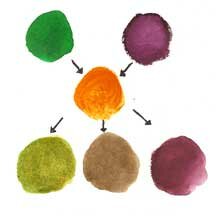What are Triad Colors ?

Pure Triad Colors combine every fourth color on the Basic Color Wheel.
This gives you 4 different palette choices of 3 colors each.
- 3 Primary Colors – Yellow + Red + Blue
- 3 Secondary Colors – Orange + Violet + Green
- 3 Tertiary Colors – Yellow/Orange + Red/Violet +Blue/Green
- 3 Tertiary Colors – Yellow/Green + Red/Orange +Blue/Violet
Twelve choices multiplied by three points of view totals –
36 unique palettes!
Choosing one of your three triad colors to be the dominant, ‘Mother Color’ completely changes the overall effect. For example, an Orange / Violet / Green color plan will be much different than aGreen / Orange / Violet color plan. The feeling of your palette will change as the emphasis is placed on mixtures with an alternate Mother Color as its root.
If you understand the difference between Primary, Secondary and Tertiary colors, you may have spotted an interesting challenge with this color scheme. Each of these categories will give you dramatically different results.
- 3 Primary Colors – Mixing any two will create extremely pure, clean, bright Secondary mixtures.
- 3 Secondary Colors – Mixing any two will create bright, slightly neutralized harmonies because there’s always a minor influence from the Complementary of one of the hues.
- 6 Tertiary Colors – Mixing any two involves the influence of a wide range of Analogouscolors plus the Complementary color of one of the hues. These mixtures are the most complex and interesting.
- Mixing all three of each palette will result in a wide, neutralized range of browns and greys.
Many artists work with a Triad Color Palette their whole lives because it’s quite versatile. Most never work with every Color Scheme. They might try a new one here and there. But it is importantat some point to experiment with them all. It helps to break out of old ruts. It’s also good way to refresh and revive flagging passion for painting.
There are two other Color Schemes to try which are also based on a triangular triad configuration. Be sure to check out the Complementary Triad and the Modified Triad.
How Triad Colors Work Together

In this example the Secondary Color Palette of Green /Orange / Violet has been selected.
The center swatch Orange in this Color Scheme is theMother Color. Green and Violet are shown on the top row.
By adding a tiny bit of the Orange to Green, the result is a pleasing warm green. The same thing happens when you add a little Orange to the Violet. You have a gorgeouswarm violet. The lovely neutral Brown in the middle of the bottom row is created by mixing the 3 colors of the original Triad Colors.
As with all colors on the Basic Color Wheel these pure paint colors may be harmonized even further. To make them Pastel Tints, Shades or Tones add White, Black or Grey in varying amounts. As long as you don’t add another Hue, they will always go together.
Painting Tips for Mixing Triad Colors
- Only work with your three selected colors and their mixtures.
- Make one of your colors dominant in your palette.
- To absolutely make sure your colors don’t clash, put a TINY smidgen of the Mother Color in every mixture. Keep it subtle for best results.
- Use various intensities of your palette by working with different proportions. Then adjust the values by adding white to lighten, black to darken or grey to tone down.
- For contrasting accents, choose one of the non-dominant colors. Make sure it has a tiny bit of the dominant Mother Color mixed in to soften it a touch. Otherwise these accents will jump out to the eye a bit too much.
- Experiment with various balance of mixtures on a piece of paper or in your sketchbook as reference, before you start working on a project. It will give you a better feel of the full range of colors you can achieve.
- Some pigments mixed in will be strong and overpower your starting color. Only mix a tiny bit at a time until you know your pigments. Beware of the darkest colors Blue, Violet and Black.
- If you want a very light color, start with white and add your mixtures to it slowly.
Check out these Color Schemes
Complementary Triad
Modified Triad
Rectangular Tetrad
Square Tetrad
Adjacent Tetrad
Analogous
Analogous Complementary
Multi-Color

